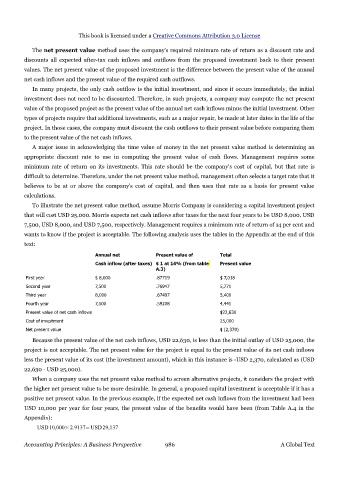Page 985 - Accounting Principles (A Business Perspective)
P. 985
This book is licensed under a Creative Commons Attribution 3.0 License
The net present value method uses the company's required minimum rate of return as a discount rate and
discounts all expected after-tax cash inflows and outflows from the proposed investment back to their present
values. The net present value of the proposed investment is the difference between the present value of the annual
net cash inflows and the present value of the required cash outflows.
In many projects, the only cash outflow is the initial investment, and since it occurs immediately, the initial
investment does not need to be discounted. Therefore, in such projects, a company may compute the net present
value of the proposed project as the present value of the annual net cash inflows minus the initial investment. Other
types of projects require that additional investments, such as a major repair, be made at later dates in the life of the
project. In those cases, the company must discount the cash outflows to their present value before comparing them
to the present value of the net cash inflows.
A major issue in acknowledging the time value of money in the net present value method is determining an
appropriate discount rate to use in computing the present value of cash flows. Management requires some
minimum rate of return on its investments. This rate should be the company's cost of capital, but that rate is
difficult to determine. Therefore, under the net present value method, management often selects a target rate that it
believes to be at or above the company's cost of capital, and then uses that rate as a basis for present value
calculations.
To illustrate the net present value method, assume Morris Company is considering a capital investment project
that will cost USD 25,000. Morris expects net cash inflows after taxes for the next four years to be USD 8,000, USD
7,500, USD 8,000, and USD 7,500, respectively. Management requires a minimum rate of return of 14 per cent and
wants to know if the project is acceptable. The following analysis uses the tables in the Appendix at the end of this
text:
Annual net Present value of Total
Cash inflow (after taxes) $ 1 at 14% (from table Present value
A.3)
First year $ 8,000 .87719 $ 7,018
Second year 7,500 .76947 5,771
Third year 8,000 .67497 5,400
Fourth year 7,500 .59208 4,441
Present value of net cash inflows $22,630
Cost of investment 25,000
Net present value $ (2,370)
Because the present value of the net cash inflows, USD 22,630, is less than the initial outlay of USD 25,000, the
project is not acceptable. The net present value for the project is equal to the present value of its net cash inflows
less the present value of its cost (the investment amount), which in this instance is -USD 2,370, calculated as (USD
22,630 - USD 25,000).
When a company uses the net present value method to screen alternative projects, it considers the project with
the higher net present value to be more desirable. In general, a proposed capital investment is acceptable if it has a
positive net present value. In the previous example, if the expected net cash inflows from the investment had been
USD 10,000 per year for four years, the present value of the benefits would have been (from Table A.4 in the
Appendix):
USD10,000×2.9137=USD29,137
Accounting Principles: A Business Perspective 986 A Global Text

